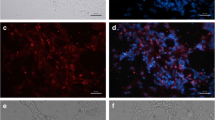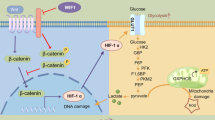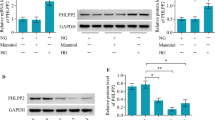Abstract
Objective
To observe the effect of sirt1 on retinal ganglion cells (RGC) with high glucose culture and to explore the role of sirt1 in the development of diabetic retinopathy. Method RGC was infected by sirt1 lentivirus overexpression vector pLV5-sirt1 and interference vector pLV3-si-sirt1. The normal control group and control virus vector group were set up at the same time. After 48 h of infection, the viability of RGC was detected by CCK8 kit, the apoptosis rate was detected by FCM analysis, and the protein expression of p53, FOXO3a, NF-κ B, caspase-3 was detected by Western blot.
Results
After RGC were infected with lentivirus, the cell viability of lentivirus overexpression vector pLV5-sirt1 was significantly higher than that of the high glucose group and the sirt1 overexpression control group, while the cell viability of interference vector pLV3-si-sirt1 was significantly lower than that of the high glucose group and the sirt1 interference control group (P < 0.05). At the same time, the apoptosis rate of RGC cells infected by lentivirus overexpression vector pLV5-sirt1 was lower than that of the high glucose group and the control virus vector group, while the apoptosis rate of the interference vector pLV3-si-sirt1 cells was significantly higher than that of the high glucose group and the control virus vector group (P < 0.05). The results of Western blotting showed that the expression of p53, FOXO3a, NF-κ B and caspase-3 in RGC cells decreased significantly after infection with pLV5-sirt1 compared with the high glucose group and the control virus vector group, while the expression of p53, FOXO3a, NF-κB and caspase-3 in RGC cells increased significantly after infection with pLV3-si-sirt1 (P < 0.05).
Conclusion
Sirt1 can inhibit the apoptosis of RGCs through regulating the expression of some apoptotic cytokinessome, and it can be used as a candidate gene for the biotherapy of retinal diseases.





Similar content being viewed by others
References
Bearse MA Jr, Han Y, Schneck ME, Barez S, Jacobsen C, Adams AJ (2004) Local multifocal oscillatory potential abnormalities in diabetes and early diabetic retinopathy. Invest Ophthalmol Vis Sci 45:3259–3265
Ghirlanda G, Di Leo MA, Caputo S, Cercone S, Greco AV (1997) From functional to microvascular abnormalities in early diabetic retinopathy. Diabetes Metab Rev 13:15–35
Allen DA, Yaqoob MM, Harwood SM (2005) Mechanisms of high glucose induced apoptosis and its relationship to diabetic complications. J Nutr Biochem 16:705–713 (PubMed: 16169208)
Barber AJ, Gardner TW, Abcouwer SF (2011) The significance of vascular and neural apoptosis to the pathology of diabetic retinopathy. Invest Ophthalmol Vis Sci 52:1156–1163 (PubMed: 21357409)
Grassi MA, Sun W, Gangaputra S, Cleary PA, Hubbard L, Lachin JM, Gao X, Kiss S, Barkmeier AJ, Almony A, Davis M, Klein R, Danis RP (2013) Validity of self-report in type 1 diabetic subjects for laser treatment of retinopathy. Ophthalmology 120:2580–2586. https://doi.org/10.1016/j.ophtha.2013.06.002
Oku H, Morishita S, Horie T, Kida T, Mimura M, Kojima S, Ikeda T (2017) P7C3 suppresses neuroinflammation and protects retinal ganglion cells of rats from optic nerve crush. Invest Ophthalmol Vis Sci 58:4877–4888
Ding RB, Bao J, Deng CX (2017) Emerging roles of SIRT1 in fatty liver diseases. Int J Biol Sci. 13(7):852–867 (Published 2017 Jul 6)
Zeng K, Feng QG, Lin BT, Ma DH, Liu CM (2017) Effects of microRNA-211 on proliferation and apoptosis of lens epithelial cells by targeting SIRT1 gene in diabetic cataract mice. Biosci Rep. 37(4):BSR20170695 (Published 2017 Jul 27)
Qing Y, Jirong Z, Yi Y, Qian Z, Jianning Li, Yuning S (2016) Construction of lentiviral vector containing sirt1 gene and its expression in retinal ganglion cell. Chin J Fundus Dis 32(1):66–69
Bai Ru, Zhou Yue, Lu Xiaohong, Cai Jinjin, Yao Qing. (2017)The effect of shRNA interference lentivirus vector targeting rat Sirt1 gene on the expression of Sirt1 in retinal ganglion cell, 33(5): 503–507
Jung KI, Kim JH, Park HY, Park CK (2013) Neuroprotective effects of cilostazol on retinal ganglion cell damage in diabetic rats. J Pharmacol Exp Ther 345:457–463
Khan T, Bertram MY, Jina R, Mash B, Levitt N, Hofman K (2013) Preventing diabetes blindness: cost effectiveness of a screening programme using digital non-mydriatic fundus photography for diabetic retinopathy in a primary health care setting in South Africa. Diabetes Res Clin Pract 101:170–176
Klein BE (2007) Overview of epidemiologic studies of diabetic retinopathy. Ophthalmic Epidemiol 14:179–183
Si-Yang L, Ling C, Xiao-Cheng L, Qi-Kuan H, Lan-Jie H (2018) Lycium barbarum polysaccharide protects diabetic peripheral neuropathy by enhancing autophagy via mTOR/ p70S6K inhibition in Streptozotocin-induced diabetic rats. J Chem Neuro. 89:37–42
Kim D, Nguyen MD, Dobbin M, Fischer A, Baur JA, Sui G, Armour SM (2007) SIRT1 deacetylase protects against neurodegeneration in models for Alzheimer’s disease and amyotrophic lateral sclerosis[J]. EMBO J. 26(13):3169–3179
Mishra M, Arul J, Renu A (2018) Sirt1: A Guardian of the Development of Diabetic Retinopathy. Diabetes 67:745–754
Zeng L, Chen R, Liang F (2009) Silent information regulator, Sirtuin 1, and age-related diseases. Geriatr Gerontol Int 9:7–15
Voelter-Mahlknecht S, Mahlknecht U (2006) Cloning, chromosomal characterization and mapping of the NAD-dependent histone deacetylases gene sirtuin1. Int J Mol Med 17(1):59–67
Vaquero A, Scher M, Lee D, Erdjument-bromage H, Tempst P, Reinberg D (2004) Human Sirt1 interacts with histone H1 and promotes formation of facultative heterochromatin[J]. Mol Cell 16(1):93–105
Zhang P, Li Y, Du Y, Li G, Wang L, Zhou F (2016) Resveratrol ameliorated vascular calcification by regulating Sirt-1 and Nrf2. Transplant Proc 48(10):3378–3386
Zhihao Wu, Lauer TW, Sick A, Hackett SF, Campochiaro PA (2007) Oxidative stress modulates complement factor H expression in retinal pigmented epithelial cells by acetylation of FOXO3. J Biol Chem 282(31):22414–22425
Appella E, Anderson CW (2019) Post-translational modifications and activation of p53 by genotoxic stresses. Eur J Biochem 268:2764–2772
Brooks CL, Gu W (2003) Ubiquitination, phosphorylation and acetylation: The molecular basis for p53 regulation. Curr Opin Cell Biol 15:164–171
Luo J, Nikolaev AY, Imai S, Chen D, Su F, Shiloh A, Guarente L, Gu W (2011) Negative control of p53 by Sir2alpha promotes cell survival under stress. Cell 107(2):137–148
Brunet A, Sweeney LB, Fitzhugh Sturgill J, Chua KF, Greer PL, Lin Y, Tran H, Ross SE, Mostoslavsky R, Cohen HY, Hu LS, Cheng H-L, Jedrychowski MP, Gygi SP, Sinclair DA, Alt FW, Greenberg ME (2004) Stress-dependent regulation of FOXO transcription factors by the SIRT1 deacetylase[J]. Science 303(5666):2011–2015
Martin A, Tegla CA, Cudrici CD, Kruszewski AM, Azimzadeh P, Boodhoo D, Mekala AP, Rus V, Rus H (2015) Role of SIRT1 in autoimmune demyelination and neurodegeneration. Immunol Res 61(3):187–197
Jeong H, Cohen DE, Cui L, Supinski A, Savas JN, Mazzulli JR, Yates JR, Bordone L, Guarente L, Krainc D (2011) SIRT1 mediates neuroprotection from mutant huntingtin by activation of the TORC1 and CREB transcriptional pathway. Nat Med 18(1):159–165
Adamiec-Mroczek J, Zajac-Pytrus H, Misiuk-Hojlo M (2015) (2015) Caspase-Dependent Apoptosis of Retinal Ganglion Cells During the Development of Diabetic Retinopathy[J]. Adv Clin Exp Med 24(3):531–535
Funding
We acknowledge support from Natural Science Foundation of China (82060819) and Ningxia Key Research and Development Project (2020BEG03033), Innovation and entrepreneurship training program of Ningxia Medical University.
Author information
Authors and Affiliations
Contributions
Yue Zhou and Lianjun Cai performed laboratory testing and edited and checked the accuracy of the manuscript. Lihui Xu and Yu Guo performed laboratory testing. Nuo Chen contributed to the sample collection and data analysis. Qing Yao was responsible for study design and recruitment, contributed to the sample collection and data analysis, and reviewed and edited the manuscript. Qing Yao is the guarantor of this work and, as such, had full access to all the data in the study and takes responsibility for the integrity of the data and the accuracy of the data analysis.
Corresponding author
Ethics declarations
Conflict of interest
No potential conflicts of interest relevant to this article were reported.
Data analysis
Qing Yao is the guarantor of this work and, as such, had full access to all the data in the study and takes responsibility for the integrity of the data and the accuracy of the data analysis.
Additional information
Publisher's Note
Springer Nature remains neutral with regard to jurisdictional claims in published maps and institutional affiliations.
Yue Zhou and Lian-jun Cai: These authors contributed equally to this work
Rights and permissions
About this article
Cite this article
Zhou, Y., Cai, Lj., Xu, Lh. et al. The role of sirt1 in the retinal ganglion cells cultured by high glucose. Int Ophthalmol 41, 845–852 (2021). https://doi.org/10.1007/s10792-020-01638-4
Received:
Accepted:
Published:
Issue Date:
DOI: https://doi.org/10.1007/s10792-020-01638-4




